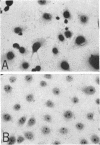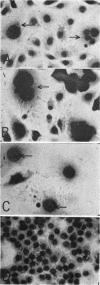Abstract
Maassab, H. F. (University of Michigan, Ann Arbor), and J. A. Veronelli. Characteristics of serially propagated monkey kidney cell cultures with persistent rubella infection. J. Bacteriol. 91:436–441. 1966.—A persistent infection of LLC-MK2 cells with rubella virus has been established and maintained for over 3 years. This “carrier culture,” designated as LLC-MK2-RAL, possesses distinct morphological and biological characteristics when compared with the original uninfected LLC-MK2 line. The mechanism of viral persistance has not been entirely elucidated, but available data suggest a regulated infection with transmission of the virus directly from cell to cell or through cell division. Interferon was isolated from RAL (rubella-associated line) culture, which explains partly the wide spectrum of resistance to superinfecting viruses. Amantadine, although inhibiting cultures of LLC-MK2 cells infected with rubella virus, failed to cure the “carrier culture.”
Full text
PDF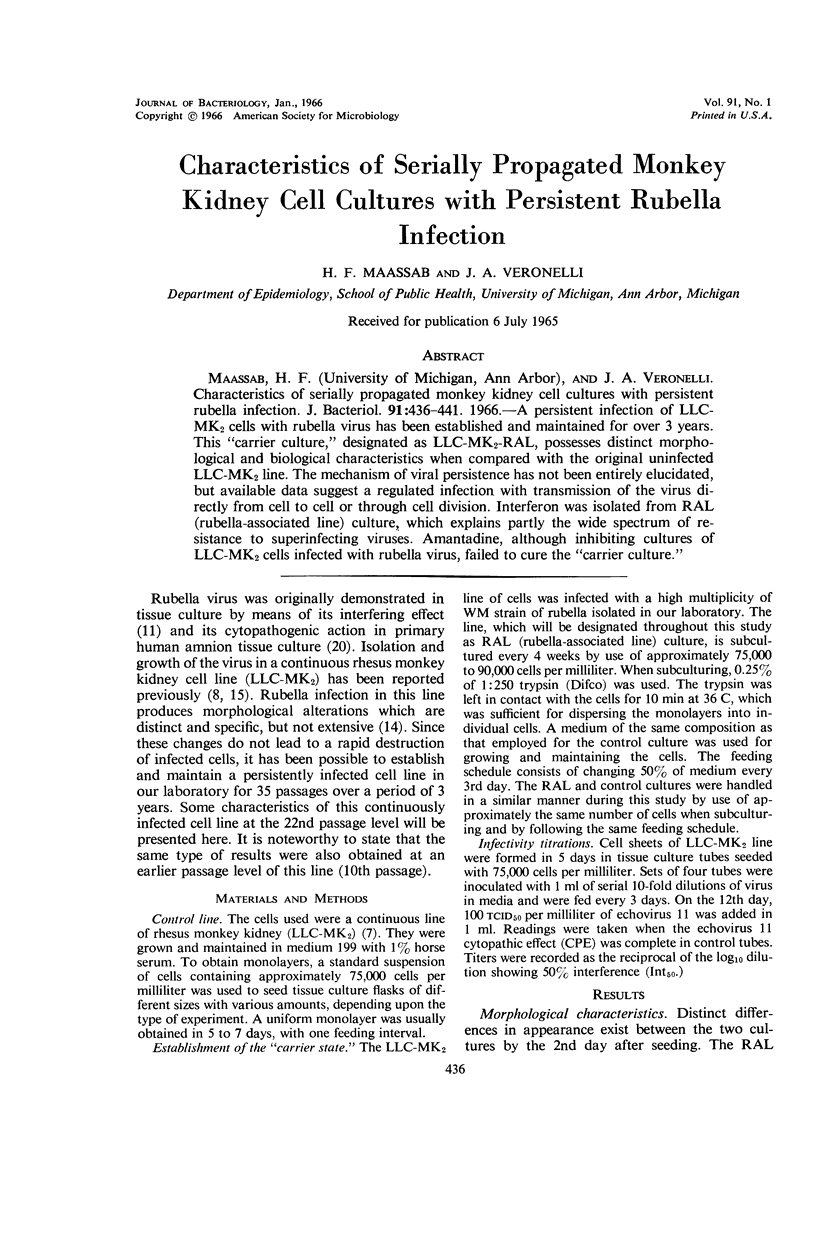
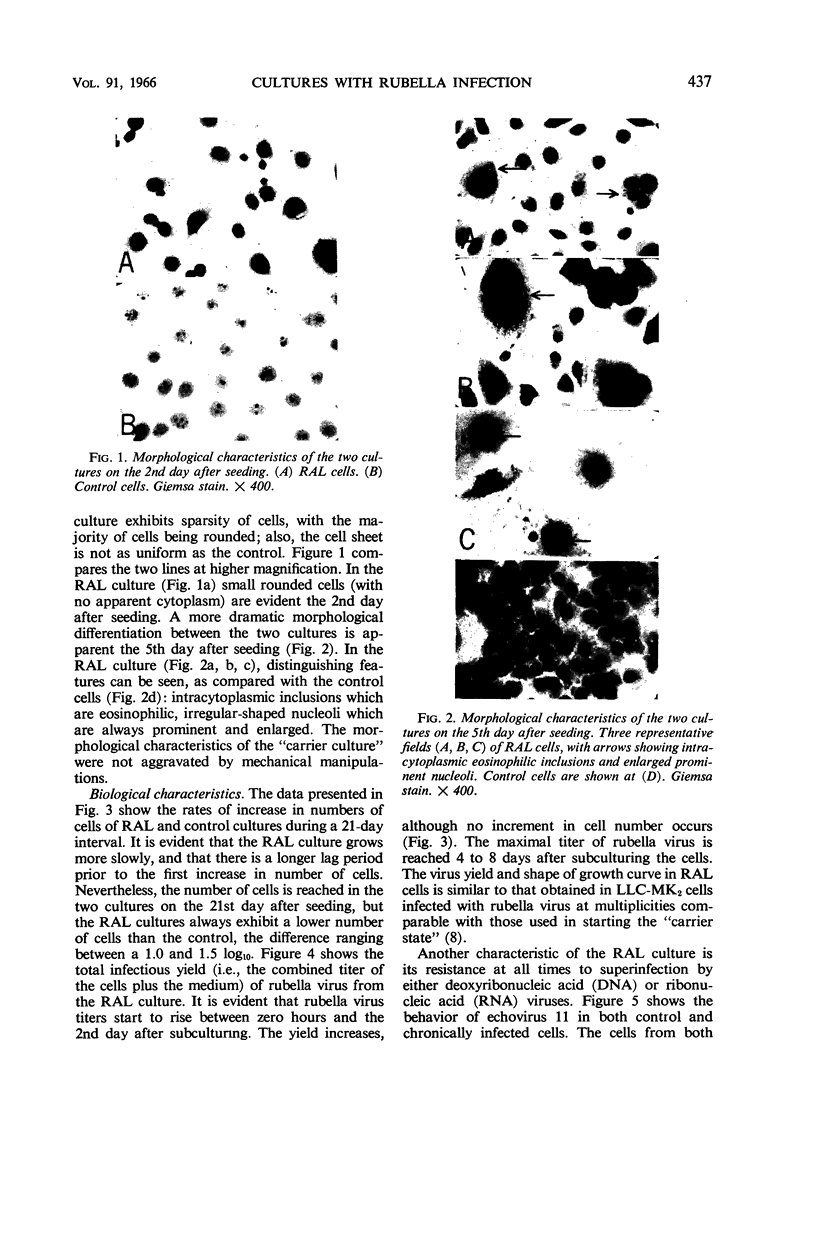
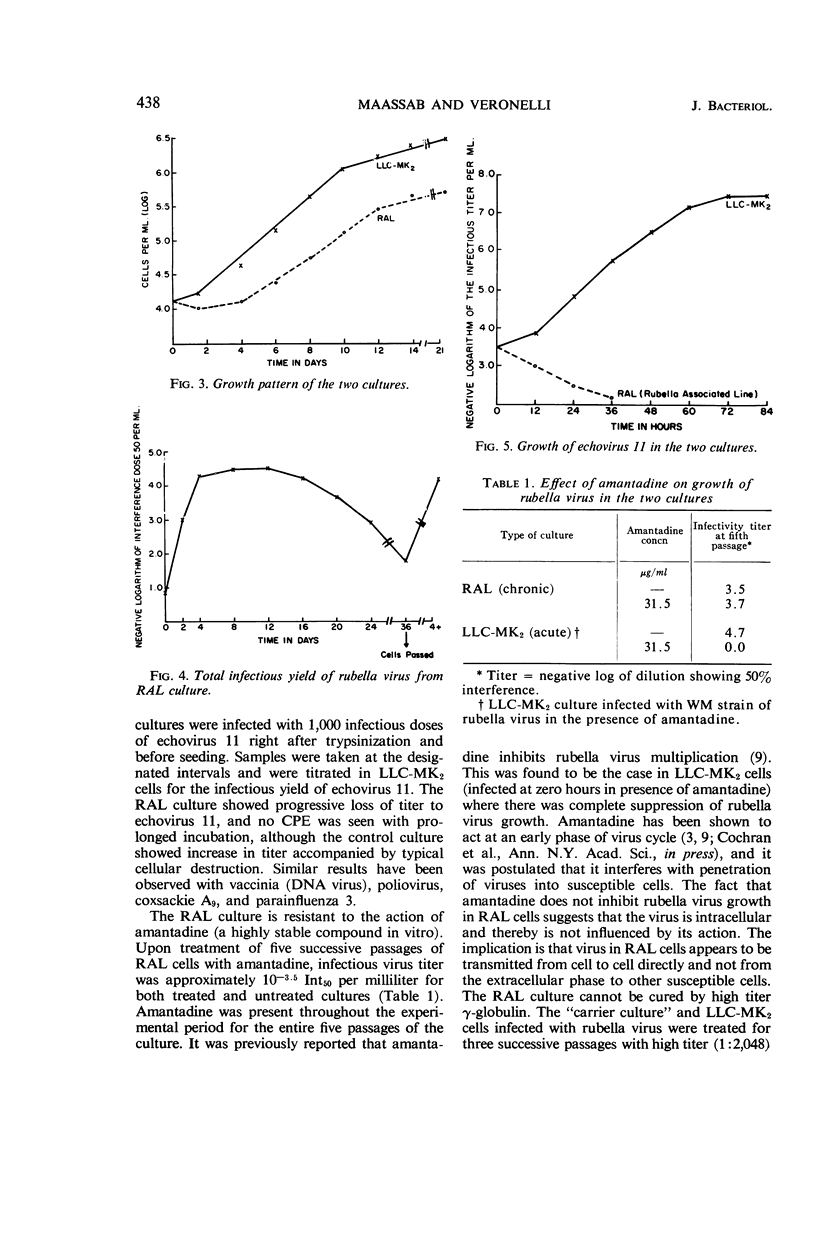
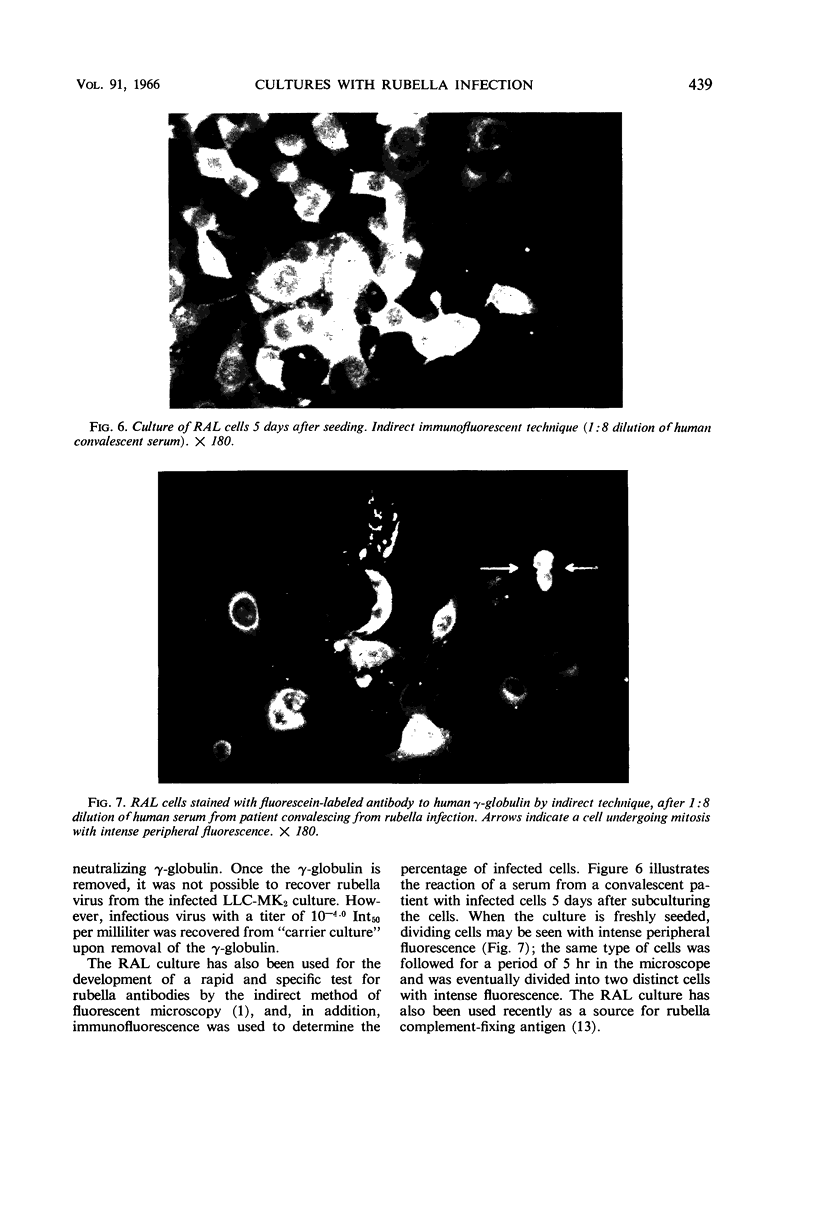
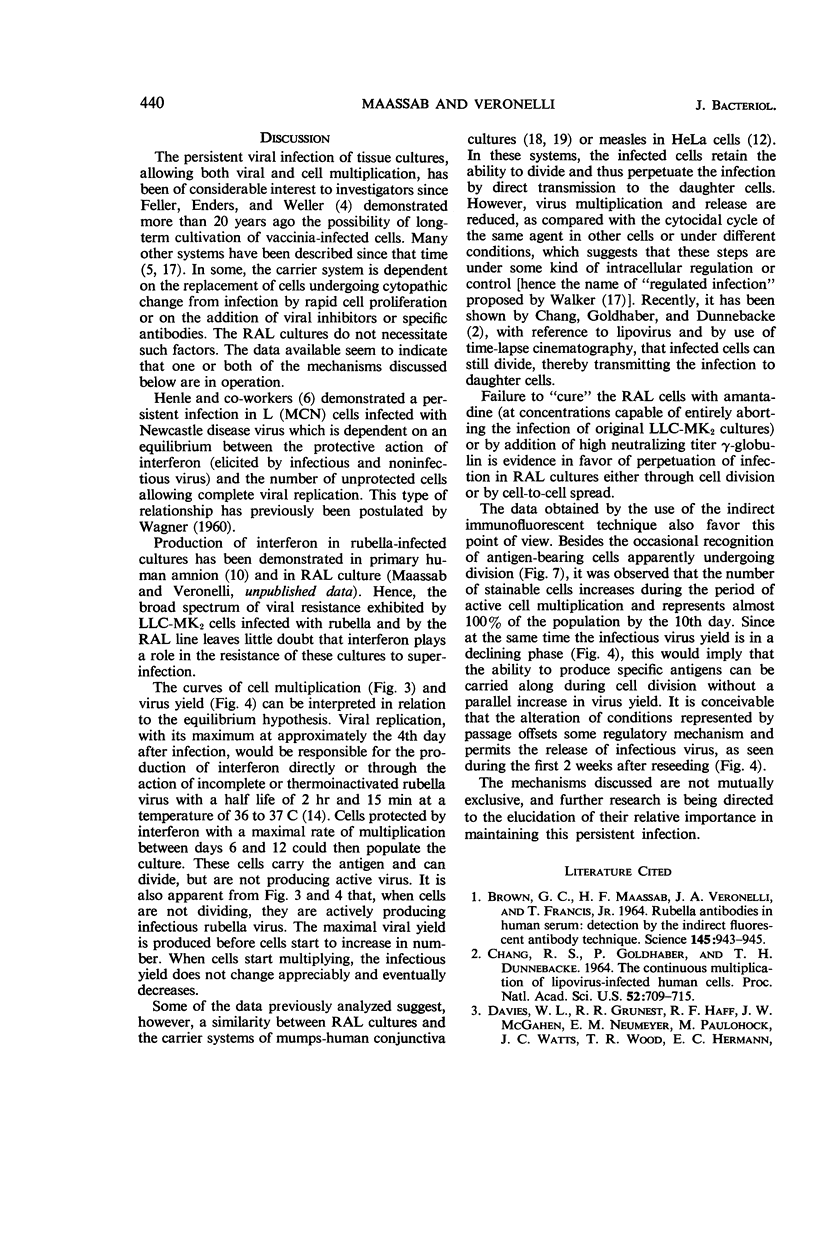
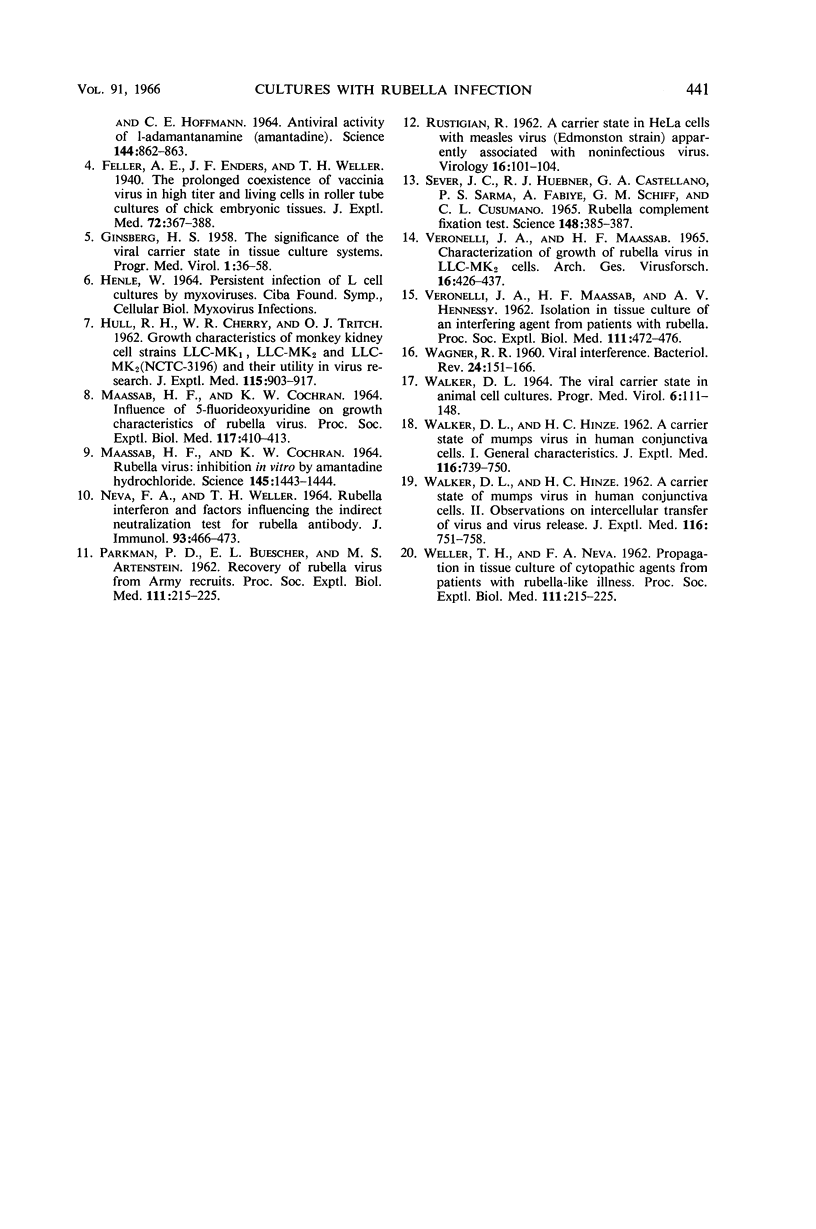
Images in this article
Selected References
These references are in PubMed. This may not be the complete list of references from this article.
- BROWN G. C., MAASSAB H. F., VERONELLI J. A., FRANCIS T. J., Jr RUBELLA ANTIBODIES IN HUMAN SERUM: DETECTION BY THE INDIRECT FLUORESCENT ANTIBODY TECHNIC. Science. 1964 Aug 28;145(3635):943–945. doi: 10.1126/science.145.3635.943. [DOI] [PubMed] [Google Scholar]
- CHANG R. S., GOLDHABER P., DUNNEBACKE T. H. THE CONTINUOUS MULTIPLICATION OF LIPOVIRUS-INFECTED HUMAN CELLS. Proc Natl Acad Sci U S A. 1964 Sep;52:709–715. doi: 10.1073/pnas.52.3.709. [DOI] [PMC free article] [PubMed] [Google Scholar]
- DAVIES W. L., GRUNERT R. R., HAFF R. F., MCGAHEN J. W., NEUMAYER E. M., PAULSHOCK M., WATTS J. C., WOOD T. R., HERMANN E. C., HOFFMANN C. E. ANTIVIRAL ACTIVITY OF 1-ADAMANTANAMINE (AMANTADINE). Science. 1964 May 15;144(3620):862–863. doi: 10.1126/science.144.3620.862. [DOI] [PubMed] [Google Scholar]
- GINSBERG H. S. The significance of the viral carrier state in tissue culture systems. Prog Med Virol. 1958;1:36–58. [PubMed] [Google Scholar]
- HULL R. N., CHERRY W. R., TRITCH O. J. Growth characteristics of monkey kidney cell strains LLC-MK1, LLC-MK2, and LLC-MK2(NCTC-3196) and their utility in virus research. J Exp Med. 1962 May 1;115:903–918. doi: 10.1084/jem.115.5.903. [DOI] [PMC free article] [PubMed] [Google Scholar]
- MAASSAB H. F., COCHRAN K. W. INFLUENCE OF 5-FLUORODEOXYURIDINE ON GROWTH CHARACTERISTICS OF RUBELLA VIRUS. Proc Soc Exp Biol Med. 1964 Nov;117:410–413. doi: 10.3181/00379727-117-29595. [DOI] [PubMed] [Google Scholar]
- MAASSAB H. F., COCHRAN K. W. RUBELLA VIRUS: INHIBITION IN VITRO BY AMANTADINE HYDROCHLORIDE. Science. 1964 Sep 25;145(3639):1443–1444. doi: 10.1126/science.145.3639.1443. [DOI] [PubMed] [Google Scholar]
- NEVA F. A., WELLER T. H. RUBELLA INTERFERON AND FACTORS INFLUENCING THE INDIRECT NEUTRALIZATION TEST FOR RUBELLA ANTIBODY. J Immunol. 1964 Sep;93:466–473. [PubMed] [Google Scholar]
- PARKMAN P. D., BUESCHER E. L., ARTENSTEIN M. S. Recovery of rubella virus from army recruits. Proc Soc Exp Biol Med. 1962 Oct;111:225–230. doi: 10.3181/00379727-111-27750. [DOI] [PubMed] [Google Scholar]
- RUSTIGIAN R. A carrier state in HeLa cells with measles virus (Edmonston strain) apparently associated with non-infectious virus. Virology. 1962 Jan;16:101–104. doi: 10.1016/0042-6822(62)90212-x. [DOI] [PubMed] [Google Scholar]
- SEVER J. L., HUEBNER R. J., CASTELLANO G. A., SARMA P. S., FABIYI A., SCHIFF G. M., CUSUMANO C. L. RUBELLA COMPLEMENT FIXATION TEST. Science. 1965 Apr 16;148(3668):385–387. doi: 10.1126/science.148.3668.385. [DOI] [PubMed] [Google Scholar]
- VERONELLI J. A., MAASSAB H. F. CHARACTERIZATION OF GROWTH OF RUBELLA VIRUS IN LLC-MK 2 CELLS. Arch Gesamte Virusforsch. 1965;16:426–437. doi: 10.1007/BF01253851. [DOI] [PubMed] [Google Scholar]
- VERONELLI J. A., MAASSAB H. F., HENNESSY A. V. Isolation in tissue culture of an interfering agent from patients with rubella. Proc Soc Exp Biol Med. 1962 Nov;111:472–476. doi: 10.3181/00379727-111-27826. [DOI] [PubMed] [Google Scholar]
- WALKER D. L., HINZE H. C. A carrier state of mumps virus in human conjunctiva cells. I. General characteristics. J Exp Med. 1962 Nov 1;116:739–750. doi: 10.1084/jem.116.5.739. [DOI] [PMC free article] [PubMed] [Google Scholar]
- WALKER D. L., HINZE H. C. A carrier state of mumps virus in human conjunctiva cells. II. Observations on intercellular transfer of virus and virus release. J Exp Med. 1962 Nov 1;116:751–758. doi: 10.1084/jem.116.5.751. [DOI] [PMC free article] [PubMed] [Google Scholar]
- WALKER D. L. THE VIRAL CARRIER STATE IN ANIMAL CELL CULTURES. Prog Med Virol. 1964;6:111–148. [PubMed] [Google Scholar]
- Wagner R. R. VIRAL INTERFERENCE. SOME CONSIDERATIONS OF BASIC MECHANISMS AND THEIR POTENTIAL RELATIONSHIP TO HOST RESISTANCE. Bacteriol Rev. 1960 Mar;24(1):151–166. doi: 10.1128/br.24.1.151-166.1960. [DOI] [PMC free article] [PubMed] [Google Scholar]



